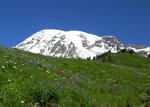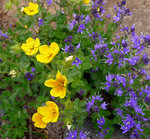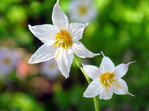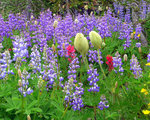



The end of July means Mount Rainier’s world-famous wildflowers have made their colorful debut, a vibrant display welcoming park visitors during the Centennial of the National Park Service.
“Wildflower season is a busy and breathtaking time at Mount Rainier,” said Mary Kay Nelson, executive director of Visit Rainier. “Part of what makes wildflower season so exciting is different flowers bloom at different elevations around the mountain at different times. A person could make several trips throughout the season and see something new every time. In fact, because it is such a popular time to visit, we encourage guests to try enjoying the park in the early morning, or later in the afternoon or evening when the crowds aren’t as large.”
While many think of mesmerizing images on trails such as the Skyline Trail at Paradise or Summerland on the route to Sunrise, there are also several spots folks can experience acres of wildflowers without even having to leave the car. The meadows around Tipsoo Lake at the top of Chinook Pass are easy to view from the road, as are the meadows surrounding the Sunrise and Paradise areas on Mount Rainier.
Crystal Mountain Resort's Mount Rainier gondola can whisk visitors up to 6,872 feet and put them in the heart of wildflower meadows. Any of these sites are a good option for folks of all ages, and physical abilities.
Learn more at www.visitrainier.com.
Top 10 Wildflower Locations
1. Reflection Lake
You don’t have to venture far from the car to be dazzled by the scenery if you start your hike at Reflection Lakes. There are two approaches to Reflection Lakes; the longer approach is from Paradise on the Lakes Trail — the shorter approach is from the Reflection Lakes trailhead on the Stevens Canyon Highway. If the wildflower displays are not enough to make you heady, there’s the postcard view of Mount Rainier. It gets even better — when Mount Rainier is not obscured by clouds the mountain casts its reflection in the lakes (hence, Reflection Lakes). Stroll along the lakeshore on the designated trail or venture a further onto the Lakes Trail for different wildflower displays and views. If you are lodging inside the park or nearby you can view these lakes at sunset, watch Mount Rainier turn rosy when tinted with alpenglow.
2. Sheep Lake
This luminous gem is not only a spectacular day hike; it is also ideal for an easy backpack for beginning backpackers or families with children. Since Sheep Lake lies outside the park, you don’t need to make reservations to camp — campsites are on a first-come first-serve basis. The hike begins on the Pacific Crest Trail at Chinook Pass and heads east on an easy grade. As you hike toward the lake look for Indian paintbrush, false hellebore, Western pasqueflower, sweetly-scented valerian and more. Look back for views of Mount Rainier or down to the green meadows that border state Route 410 as it wends its way eastward. For a more moderate hike continue on to Sourdough Gap, an airy notch between a ridgeline of rugged peaks for views in all directions.
3. Grand Park
Grand Park is one of the largest meadows inside the park, a plateau of wildflowers dotted with silver snags — not to mention the view of Mount Rainier. In summer, Grand Park is a green sea of billowing wildflowers including magenta paintbrush; in late summer look for asters and gentians. The long approach starts from Sunrise, a hike best suited for strong hikers. The shortest approach is from Forest Service Road 73 (Huckleberry Creek Road ) via state Route 410. However, the gravel road is steep, narrow and best suited for a four-wheel drive vehicle. Parking is limited; a Northwest Forest Pass is required. Grand Park melts out later than trails at Paradise so in heavy snow years you may see early-season flowers mixed in with later-season flowers such as asters and gentians
4. Berkeley Park From Sunrise
You can also get a sneak preview of what Grand Park is all about by hiking to Berkeley Park from Sunrise. Plus, the wow-factor begins before you even get to Sunrise (take time to stop at the Sunrise Point Overlook). When you arrive at Sunrise, pick up a trail map from the Sunrise Visitor Center. The hike begins on a spur between the restrooms and Sunrise Lodge and climbs through flower-dappled meadows to Sourdough Ridge. Turn left and follow signs (you will pass Frozen Lake). Depending on how recently snow has melted you might encounter golden glacier lilies and white avalanche lilies blooming side by side. Since there isn’t a hardline between Berkeley Park and Grand Park, you can hike further if you choose.
5. Dege Peak
How about some spectacular views to go with those wildflowers? Starting at Sunrise Dege Peak is an ideal destination for 360-degree views and wildflowers, an easy hike via the Sourdough Ridge Trail. Hike to Sourdough Ridge from Sunrise (as above) but when you get to Sourdough Ridge, turn right. The trail is an airy flower-studded path with high points along the way where you can call it a day. Children with some hiking experience will get a real kick out of this hike — Dege Peak is an ideal “first summit” for kids. Enjoy views in all directions — look down on Sunrise, meadows, bone-white snags, Mount Rainier, the Emmons glacier, to the south Mount Adams, Saint Helens and Mount Hood and to the north Mount Stuart, Mount Baker and Glacier Peak.
6. Summerland
Summerland can only be described as one of the most blissful settings a hiker could envision. The Summerland trailhead is past the Owyhigh Lakes trailhead via the White River entrance of the park. The hike begins in cool, restful forest before crossing boisterous Fryingpan Creek on a rustic footbridge. Here, you can stop for views of The Mountain; Fryingpan Creek also is a good turnaround for hikers wanting a shorter hike. If bound for Summerland, cross the creek and continue hiking as the trail switchbacks between steep flower-studded meadows before coming out at Summerland, a popular campsite along The Wonderland Trail (backcountry reservations are required). Strong hikers can continue to Panhandle Gap through old moraines and tarns (Panhandle Gap is not suitable for children or those without hiking experience as ice often lingers below Panhandle Gap well into summer).
7. Mowich Lake to Tolmie Peak
Once we counted over 60 varieties of wildflowers along the shoreline of Mowich Lake on a hike with The Mountaineers. There were so many we never made it to Tolmie Peak since then, we’ve returned several times. The trail starts from the Mowich Lake parking area on the Wonderland Trail, drops to Mowich Lake and parallels the lakeshore before climbing through forest to a junction with the Ipsut Creek trail. The Wonderland Trail drops to the Carbon River. Our trail continues climbing through forest before, then skirts a meadow often studded with avalanche lilies above pretty Eunice Lake. From Eunice Lake the trail continues, climbing a headwall to Tolmie Peak and the Tolmie Peak lookout, one of the most popular sites inside the park (who doesn’t love a lookout?). Though the trail is often crowded there’s plenty of elbow room for all.
8. Naches Loop
This is a short, moderate loop at Chinook Pass that hikers of all ages can enjoy when snow is gone. Park at the Pacific Crest Trail trailhead a bit east of Chinook Pass, hike back to the overpass at Chinook Pass (designated with an arch) where the loop begins, and hike the loop in either direction. En route you’ll pass pretty tarns and steep meadows as the trail skirts the base of Naches Peak (for climbers only!). Depending on which direction you hike, you’ll be hiking toward Mount Rainier. This hike is also spectacular in fall when green meadows turn to gold and the blossoms of mountain ash turn to bright, red berries.
9. Alta Vista
The trail to Alta Vista is a short, scenic and popular trail that is easily accessed from Paradise – it is not a trail for hikers seeking solitude. However, the trail is so spectacular you probably won’t pay much attention to other hikers or them to you. Like other trails at Paradise (with a trail map) you can create a loop and trail junctions are well signed. The trail starts out paved but soon turns to gravel with views immediately vying for your attention. Just when you think the scenery can’t get any better — it does. When the trail is not crowded you may spot a marmot sunning on a rock — if the trail is crowded you are more apt to hear their sharp whistles than see them. Don’t forget to pick up a trail map at the Henry M. Jackson Visitor Center. There are unlimited options for longer hikes and better chances for solitude.
10. Skyline Trail
This trail also starts at Paradise and while the Skyline Trail is a strenuous hike there are so many scenic viewpoints along the trail that you can designate any of them as destination, lunch spot and/or turnaround. Stop when and where you please. The Skyline Trail is also the take-off point for more demanding hikes, including Panorama Point. Hikers will not be disappointed with views of the craggy Tatoosh Range (south) and further — Mount Adams, Mount Saint Helens and Mount Hood. Depending on snowmelt you may find the meadows carpeted with avalanche lilies, soon to be replaced with other colorful flowers ranging from lupine to Indian paintbrush.